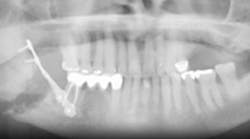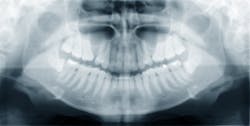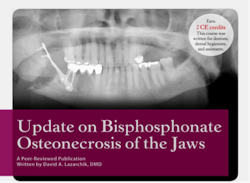According to the National Institutes of Health (NIH), osteonecrosis is a disease where new bone does not replace old, resorbing bone quickly enough. The cause is attributed to less flow of blood to the affected area. (1) Osteonecrosis can occur in any bone, but we will discuss osteonecrosis of the jaw (ONJ).
According to the American College of Rheumatology, ONJ “is associated with cancer treatments (including radiation), infection, long-term steroid use, or potent antiresorptive therapies that help prevent the loss of bone mass.” (2) Some of these antiresorptive pharmaceuticals are bisphosphonates such as alendronate (Fosamax), risedronate (Actonel and Atelvia), ibandronate (Boniva), and denosumab (Prolia). (2)
The American Academy of Oral Medicine (AAOM) has a question and answer page on bisphosphonate therapy and its connection to ONJ. It mentions that ONJ has been reported by those taking bisphosphonates and having a procedure such as tooth extraction or other invasive dental procedures. The AAOM considers ONJ a rare side effect for those taking oral bisphosphonates. (3)
ONJ seemed to surface about 2003, and the mechanisms surrounding it are somewhat unclear. According to researchers at University of California, Los Angeles (UCLA), we need further research about how ONJ develops and advances at a cellular level in order to develop preventive measures and interventions against it. (4) Drugs that may cause ONJ inhibit the action of osteoclasts (i.e., the cells that break down bone). It is suspected that this activity goes awry and causes ONJ, but researchers are not sure of the exact manner this works. The recent publication of the UCLA animal study concludes that drugs like bisphosphonates interfere with osteoclasts bone-resorbing functions, and suppress woven bone formation after dental trauma. This may be a possible explanation of their link to ONJ. (4)
ONJ is also linked to drugs like denosumab (Prolia), an injection drug used to treat osteoporosis, but no causal relationship has been established. (5) Bisphosphonates and denosumab reduce the rate of bone turnover and possibly decrease the effectiveness of the body’s resistance to infection. (6) Researchers of one study conclude that infection should be viewed more critically in ONJ, and that “ONJ with infection at the epicenter could justify temporary discontinuation of the ‘offending drug’ to allow recovery of macrophage production and function.” (6) Traumatic procedures should be minimized or eliminated, and harmful pathogens should be prevented from reaching the bone surface by optimal hygiene procedures. (6)
Another review illuminated the role and mechanisms of diabetes in medication-caused ONJ. Factors may include damage to the microvasculature, “endothelial cell dysfunction, reduced remodeling of bone, and increased apoptosis of osteoblasts and osteocytes.” (7) They also suspect that an impaired immune system can promote inflammation, and be an additional factor in ONJ.
“Update on Bisphosphonate Osteonecrosis of the Jaws,” a 2-credit CE course, is available at iNeedCE.com.
References
1. Osteonecrosis. Medline Plus. http://www.nlm.nih.gov/medlineplus/osteonecrosis.html. Updated February 10, 2014. Accessed April 24, 2015.
2. Osteonecrosis of the Jaw (ONJ). American College of Rheumatology website. http://www.rheumatology.org/Practice/Clinical/Patients/Diseases_And_Conditions/Osteonecrosis_of_the_Jaw_%28ONJ%29/. Updated September 2012. Accessed April 24, 2015.
3. Bisphosphonate Therapy. The American Academy of Oral Medicine website. http://www.aaom.com/index.php?option=com_content&view=article&id=78:bisphosphonate-therapy&catid=22:patient-condition-information&Itemid=120. Published January 8, 2008. Accessed April 24, 2015.
4. Williams DW, Lee C, Kim T, et al. Impaired bone resorption and woven bone formation are associated with development of osteonecrosis of the jaw-like lesions by bisphosphonate and anti-receptor activator of NF-κB ligand antibody in mice. Am J Pathol. 2014;184:3084-93.
5. Denosumab injection. MedlinePlus. http://www.nlm.nih.gov/medlineplus/druginfo/meds/a610023.html. Updated January 15, 2014. Accessed April 24, 2015.
6. Katsarelis H, Shah NP, Dhariwal DK, Pazianas M. Infection and medication-related osteonecrosis of the jaw. J Dent Res. 2015;94:534-539.
7. Peer A, Khamaisi M. Diabetes as a risk factor for medication-related osteonecrosis of the jaw. J Dent Res. 2015;94:252-60.









